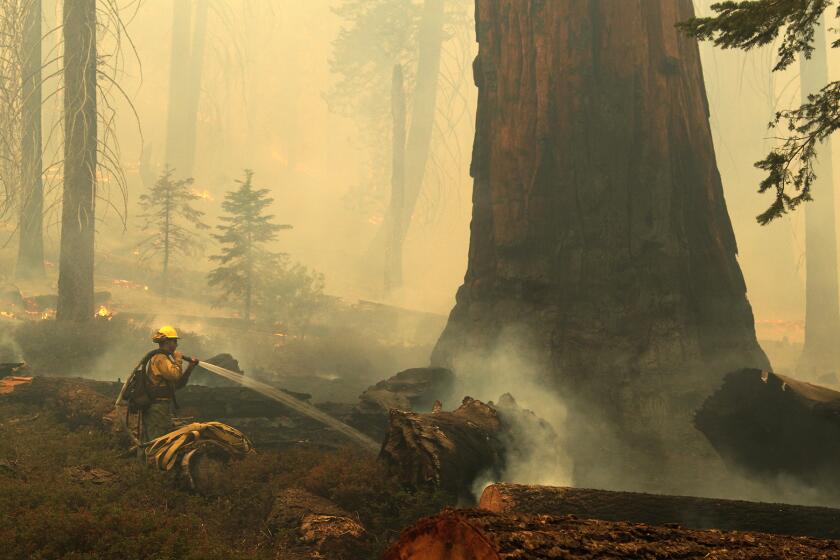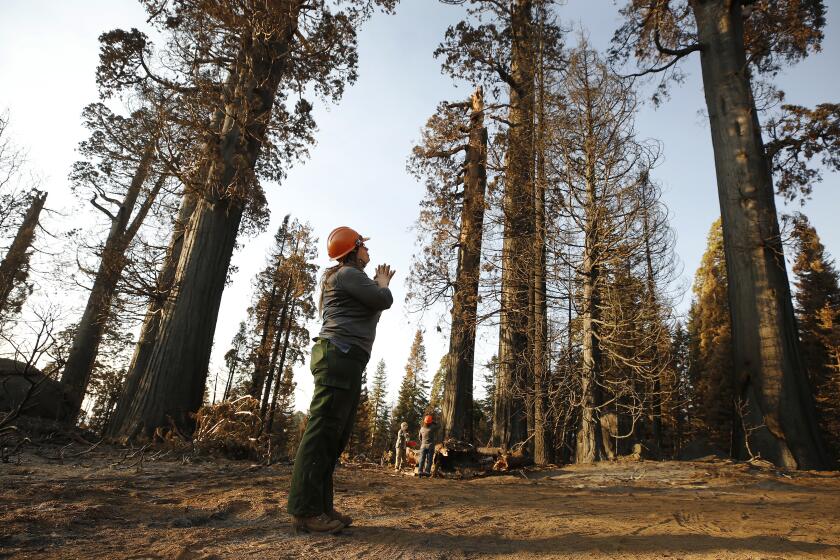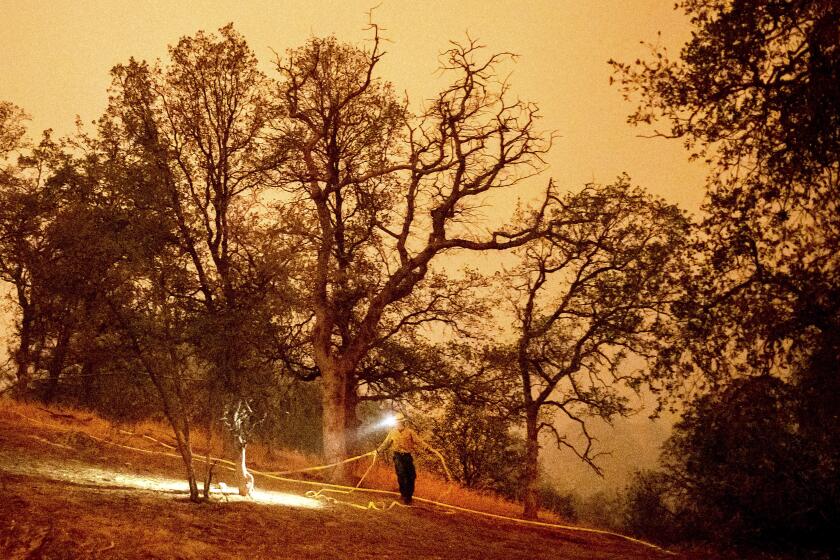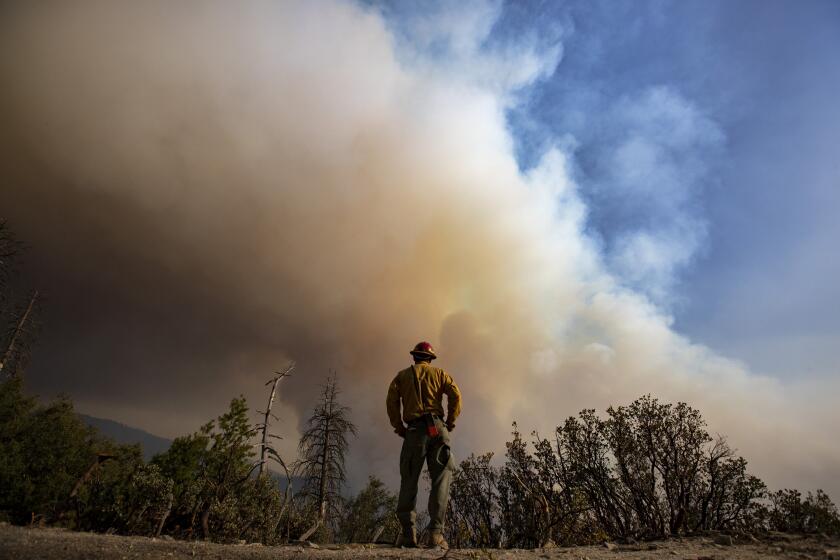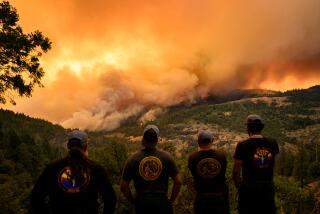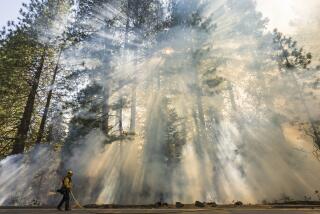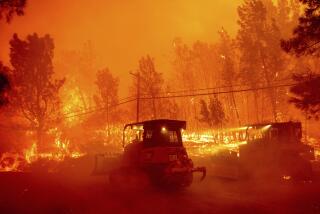The bold firefighting strategies that saved some of the world’s largest sequoias
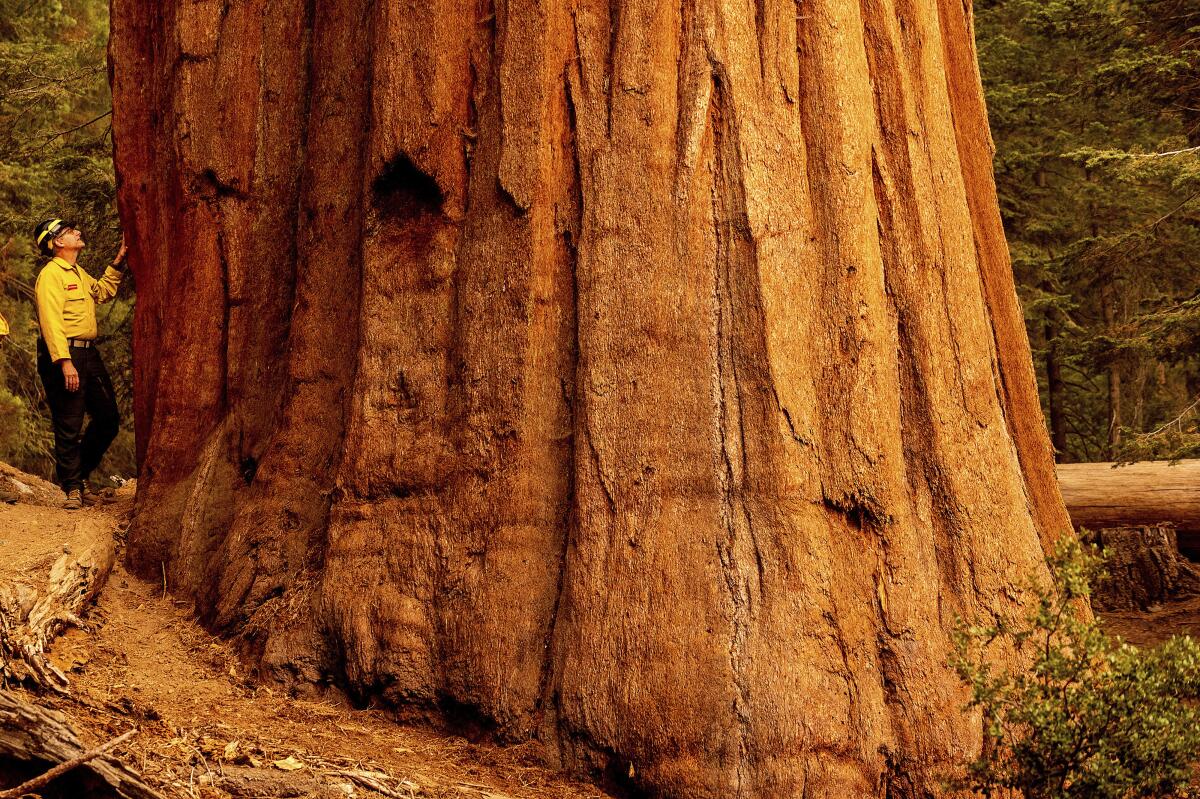
When wildfire raced toward Sequoia National Park’s largest concentration of giant sequoias, officials sprang into action.
Crews raked vegetation from the trees’ enormous bases. Hotshot personnel lighted low-intensity fires to burn off duff and litter. Firefighters wrapped protective foil around the trunks of some monarchs — a tactic that is typically used to guard buildings against flames.
And there were other measures already in place: Controlled burns and mechanical thinning performed in the Giant Forest years ago would enable crews to extinguish spot fires as the flame front approached, said Mike Theune, regional fire information officer for the National Park Service.
So, when the KNP Complex fire hit the edge of the 489-acre Sherman prescribed burn completed in 2019, its forward advance into the area actually stopped, Theune said.
“That’s really, really good news,” he said. “It shows the effectiveness, and why it’s so important that we come together as we look to protect these giant sequoias for each generation.”
Flames from the Windy fire are chewing the trunks of trees within Long Meadow Grove, home to some 1,500-year-old sequoias along the Trail of 100 Giants.
By Monday, it appeared the trees had escaped major damage, although there was still concern about groves that did not have a recent burn history, such as Muir Grove and Lost Grove on the park’s north side, Theune said.
The frenzied rescue efforts speak to new worries over the fate of California’s towering trees. Many are concerned that the state’s new breed of faster, hotter and larger wildfires could upend the delicate ecological balance that has allowed the giants to thrive for centuries. Giant sequoias are one of the most fire-adapted species on Earth, but climate change is lowering their defenses and making them more vulnerable to flames than ever before.
Last year’s Castle fire changed what experts thought they knew about the trees’ relationship with flames. It burned so intensely that it killed an estimated 10% to 14% of the world’s natural population, leaving a graveyard of charred trunks and scorched crowns.
“That’s not the typical way that large old giant sequoia trees interact with fire,” said Robert York, an extension specialist with UC Berkeley, who has been studying giant sequoias for 18 years and is performing research in the burn area. The trees have thick bark, huge crowns that tower high above the ground and cones that release seeds in response to bursts of heat, he said.
Still, if a fire burns intensely enough, as the Castle fire did in some areas, it can destroy their crowns and kill the seeds they release, eliminating both the old trees and the possibility of new growth, York said.
This year’s Castle fire killed hundreds of giant sequoias, the latest in a string of Sierra Nevada wildfires that is taking an alarming toll on the world’s most massive trees.
And with the giant sequoia growing only on the western slopes of the Sierra Nevada in California, there is little room for the species to absorb loss.
“This fire is really a call to action for all of us,” said Savannah Boiano, executive director of the park’s nonprofit partner, the Sequoia Parks Conservancy. “And for millions of Americans and people around the world, the call to action is personal when it’s in a place that you love.”
The Giant Forest is of such great cultural value that a specialized task force was assembled to defend it when the KNP Complex fire approached, said Ana Beatriz Cholo, incident spokeswoman.
The task force is composed of about 35 National Park Service personnel and firefighters who are specially trained to protect the sequoias. Assisting that task force were air tankers dropping fire retardant from above and sprinkler systems at the nearby Giant Forest Museum, which have been running nonstop for days, Cholo said.
The forest is home to thousands of sequoias, including General Sherman, known as the largest tree in the world by volume.
Some giant sequoias are thousands of years old, and they once benefited from low- and mixed-intensity fires that burned more frequently through the Sierra Nevada. But starting about 100 years ago, Indigenous burning practices gave way to aggressive suppression policies.
“When we started having this practice of fire exclusion and full fire suppression, we changed the dynamics of the forest,” Theune said.
Dead and downed plant material have built up while tree stands have become denser, creating more competition for resources such as light, nutrients and water, York said. Climate change has exacerbated matters by altering precipitation patterns and causing longer droughts and heat waves that prime forests to burn more easily.
The current state of many of the region’s forests is cause to be “very concerned,” said Ron Goode, tribal chairman of the North Fork Mono Tribe and a practitioner of cultural burning. Fire, he said, is not only healthy for the landscape, but necessary.
If a forest is in a healthy state, wildfire should “just be able to burn through” along the floor and not scorch the tops of trees, he said. “But if you’re waiting for the wildfire, the wildfire is going to get up on top.”
The 8,940-acre KNP Complex fire is within striking distance of Sequoia National Park’s Giant Forest, home to the largest tree on Earth, officials said.
The exclusion of low- and mixed-severity fire from sequoia groves has harmed the species in other ways, York said. Because the trees depend on fire to release seeds, they are suffering from a failure to regenerate in its absence, he said.
“Eventually, that’s not going to be sustainable,” he said.
And although the Giant Forest emerged relatively unscathed Monday, other sequoia groves may not be so lucky. The Windy fire, burning just south of the KNP Complex, has crept into Long Meadow Grove, home to some 1,500-year-old sequoias along the Trail of 100 Giants.
The fire was lapping at the trunks of some sequoias, officials said, and already on Sunday, it had reached the crown of at least one towering tree.
Wildfire has also reached some other, more remote groves, including the Peyrone Grove and the Red Hill Grove, Windy fire incident spokeswoman Amanda Munsey said.
“We don’t know that those are destroyed,” she said, “but the fire has completely surrounded those two groves.”
Much of this year’s wildfire activity has been erratic and unpredictable. Though crews feel confident about General Sherman and the rest of the Giant Forest, the KNP Complex is still 0% contained, and firefighters are heading into another stretch of long, hot days with the potential for gusty wind.
Critical fire weather conditions are expected to persist through Sunday in Sequoia National Park, where a wildfire reached the Giant Forest.
One concern is that the fundamentally altered nature of wildfires will cause parts of the mixed-conifer forests, where the sequoia live, to permanently change into shrub or grasslands. That can happen when a fire burns at such high intensity and over a large enough area that it kills all the trees and wind-dispersed seeds are unable to reach it, York said.
“Wind dispersal only carries seeds so far — maybe 200, 300 feet — so if you have a 1,000-acre patch where all the trees died, there’s a very low probability the trees have a chance of coming back,” he said. “Shrubs have the advantage because they have adapted to high-severity fire much more than the tree species we have here.”
Multiple groups are working to avoid that fate, including the Giant Sequoia Land Coalition of federal and state agencies, universities, tribes and conservationists.
The challenge is performing the kind of work that’s needed on a scale sufficient to address the problem, experts say.
Climate change has increased the window of time each year in which conditions are ripe for high-severity fire. That also means that there is less time during which controlled burns can be set due to weather conditions and the fact that crews are busy fighting fires.
The Sequoia Parks Conservancy recently launched the KNP Complex Recovery Fund to support things like hiring staff to survey and document damage to cultural and historic resources, rebuilding trails and potentially replanting, Boiano said.
Donations have been coming in from all over the world. Boiano attributes the outpouring to the emotional attachment people have to the giant sequoias. The nonprofit recently changed its fundraising portal to include a place where people can share their memories of the trees.
“People have become citizens of the United States there, people have gotten engaged, they’ve spread the ashes of loved ones,” Boiano said. “Generations and generations of memories are tied up in these parks.”
More to Read
Sign up for Essential California
The most important California stories and recommendations in your inbox every morning.
You may occasionally receive promotional content from the Los Angeles Times.
